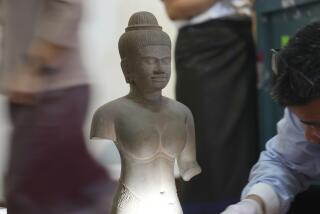Destruction of Statues Rekindles an Old Debate
- Share via
HONG KONG — The Afghan government’s decision to destroy two ancient statues of Buddha has heightened debate within the art world about how Asia’s most valued antiquities should be handled--and where they ultimately belong.
There are already signs that the incident has altered the dynamic of the debate in ways that could affect public access to art treasures far beyond the rugged mountains of Afghanistan and Central Asia.
“There’s definitely evidence that ground is shifting on this issue,” noted Elizabeth Knight, editor and publisher of Orientations, a well-regarded magazine on Asian art. “Museums [in the West] are saying, ‘We should have protected this material.’ ”
In recent years, the dispute over the right to antiquities has tended to favor those who argue that art treasures belong near their origins, rather than in collections continents away.
The weight of that opinion--sometimes denigrated by opponents as being “overly politically correct”--has frequently placed both private collectors and major museums in Europe and the United States on the defensive as they seek to protect existing collections against claims from Asian governments.
It also has given a negative aura to those in the West who want to purchase key Asian art from the region. Many Asian countries, including China, ban the export of antiquities.
Afghan supreme leader Mullah Mohammed Omar ordered the destruction of all religious statues last month, deeming them idolatrous. A spokesman for the opposition, Mohammed Ashraf Nadeem, said Friday that the Taliban regime had used a cannon and explosives to complete the destruction of the two ancient, towering statues of Buddha.
Omar’s order may shift the center of gravity on the issue.
“It does seem to have encouraged the other side of the argument in this,” noted Henry Howard-Sneyd, Sotheby’s managing director for China and Southeast Asia.
However, he cautioned that shock remained the prevailing emotion among art specialists. “The real debate had yet to take hold.”
Pointing to a pile of letters and e-mail received since news of the Afghan destruction, Knight said she believes that she’s already seen the opening shots.
“I must admit that I begin now to question our policy, and those of most museums in the Western world, to refrain from purchasing any object from the country of its origins,” wrote Marianne Yaldiz, director of the Museum for Indian Art in Berlin.
Knight believes that the Afghan incident could also influence another aspect of the same issue: how to deal with potentially rich archeological digs in Asia. Some in the West advocate a return, at least in some cases, to a practice in which Western groups provided expert help at a dig in return for some of the treasures.
Knight pointed to conditions at the massive Three Gorges Dam construction project as an example in which such a practice could save treasures. The site in central China is rich in history, a home to both Stone Age civilizations and Han Dynasty communities dating to 206 BC.
As the dam project moves forward, archeological interests in China find themselves short of resources and time to deal with the hundreds sites deemed worthy of preservation.
More to Read
The biggest entertainment stories
Get our big stories about Hollywood, film, television, music, arts, culture and more right in your inbox as soon as they publish.
You may occasionally receive promotional content from the Los Angeles Times.










